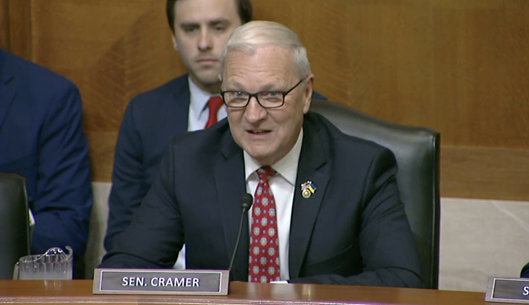WASHINGTON – U.S. Senator Kevin Cramer (R-ND), Ranking Member of the Environment and Public Works (EPW) Subcommittee on Transportation and Infrastructure, invited and introduced Ms. Karin Mongeon, the Safety Division Director for the North Dakota Department of Transportation.
In her role, Mongeon manages an annual budget consisting of both federal and state funding for behavioral traffic safety programs statewide. She also administers the state’s “Vision Zero Plan” (formerly Strategic Highway Safety Plan), which aims to reduce motor vehicle crash fatalities and serious injuries to zero. Since North Dakota launched its Vision Zero initiative in 2018, vehicle fatalities have been on a steady decline. North Dakota ended 2022 with a total of 98 motor vehicle crash fatalities, the lowest number of crash deaths in about 20 years.

OPENING STATEMENT
***Click here to download video. Click here for audio.***
In his opening remarks, Senator Cramer highlighted the significant investments included in the Infrastructure Investment and Jobs Act (IIJA) to improve highway safety and emphasized the importance of state flexibility, which is maintained and expanded under the law. The IIJA included the Safe Routes to All Schools Act, bipartisan legislation to prioritize pedestrian and bicycle safety projects for high school students who walk or bike to school. Senator Cramer highlighted local calls for increased safety in school zones. He also discussed the unique nature of each state’s highway and transportation system and due to these differences, noted, a one-size-fits-all approach to address roadway safety challenges does not work.
WITNESS QUESTIONING
***Click here to download video. Click here for audio.***
Senator Cramer first questioned how the addition of roadway capacity may prevent drivers from engaging in risky behavior to maneuver around slower-moving vehicle cars, citing U.S. Highway 85, which leads right through the Bakken, as a primary example.
“It seems apparent to me that adding capacity could help reduce congestion and improve the safety of the highways. Can you speak to how a roadway modernization project, which includes adding capacity, might provide some safety benefits outside of simply improving the movement of the goods? Which is not unimportant either. Efficiency doesn’t have to be unsafe,” said Senator Cramer.
“As you know, I am not a transportation engineer, but I work with transportation engineers daily, and I talk to them regularly. What they would say about roadway projects that increase capacity is that it's often an opportunity to add safety features to the roadways such as turn lanes, passing lanes, access consolidation, geometric improvements, such as improved line of sight or safer angles and approaching turns, or on access off ramps. I know that within the [Department of Transportation] and talking to my engineering partners, that they look at every project through the lens of safety,” said Ms. Mongeon.
He then addressed concerns mandating speed limits, especially on heavy-duty trucks, which the Federal Motor Carrier Safety Administration is actively pursuing. In North Dakota, the interstate highway speed limit is 75 miles per hour. This mandate may create a situation causing trucks to travel up to 10 miles per hour below the speed limit. As an example, Senator Cramer recalled his time on the Public Service Commission reviewing an infrastructure project that would inevitably disrupt drivers’ expectations.
“Every solution seemed to be a bad one to me because it disrupts the expectation of the driver […] Are you concerned about the potential for speed limiters on trucks to disrupt traffic flows on the highway in North Dakota and increase the likelihood of accidents as vehicles of different speeds interact?” asked Senator Cramer.
“The North Dakota [Department of Transportation] has concerns of course. North Dakota's economy is reliant upon efficient transport of industry products. Our concerns include potential adverse safety impacts, from creating speed differentials between heavy trucks and cars. So, we are aware that the U.S. [Department of Transportation] stated its intent to issue, as soon as December, a proposed rule that would require speed limits on trucks, class seven and higher. We will review that proposed rule and issue comments, but we do have concerns,” said Ms. Mongeon.